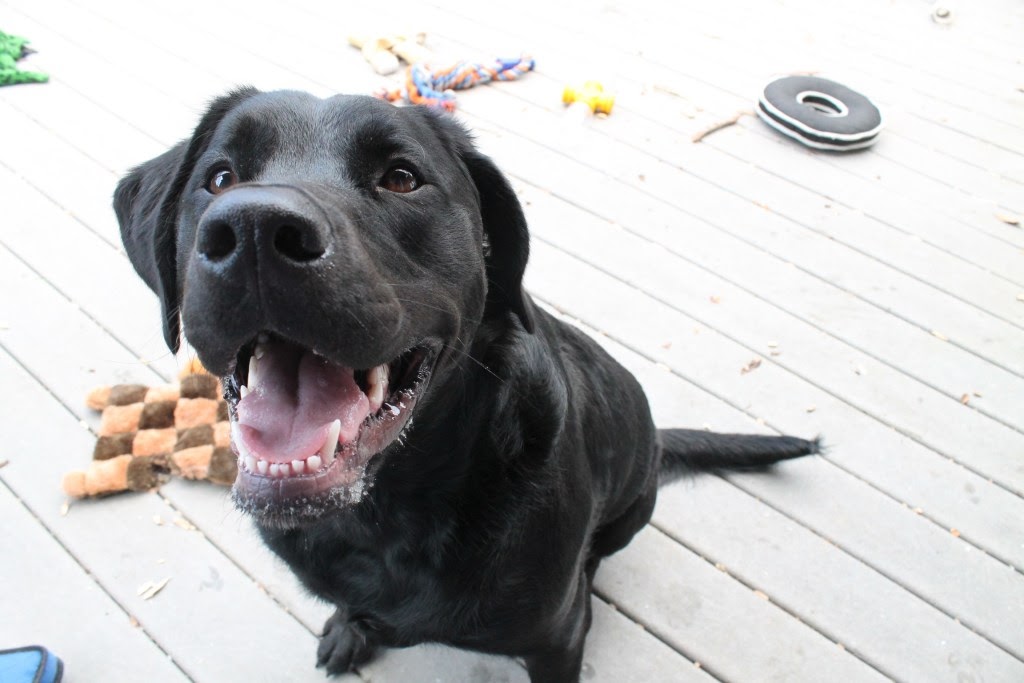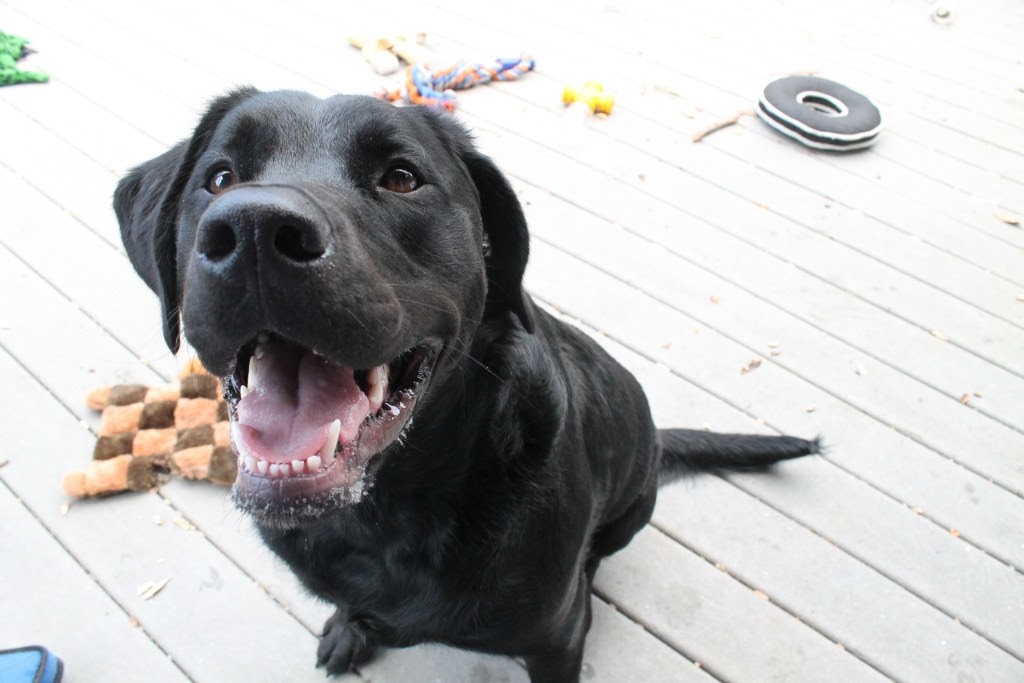First of all, congratulations on choosing to expand your family!
We consider adding a dog like adding a child + that’s for good reason: dogs are incredibly smart, emotional, intuitive mammals just like we are. They need emotional + physical inputs just like us humans, too.
Leading with that understanding, we think learning more about how the adults, children + dog are trained proves more useful than what breed the dog is or whether it came from a shelter or rescue.
That said, we have rescued a handful of dogs, volunteered for animal shelters + invested way more money than we’d like to admit on training for dogs.
In this post, we’re sharing the best of what we know about choosing a family dog so that we can shortcut the investment of time + money for you. This way, you + your family can get onto enjoying your fur-baby much faster!

Be Honest About Your Activity Level
There’s a saying “a tired dog is a happy dog” + we’ve found this to be exceptionally true.
No matter which breed you choose, every dog needs some sort of stimulation throughout the day. When a dog gets bored, they create their own entertainment.
Even the big dogs that appear lazy will do this. Big dogs just mean they can get into bigger trouble!
What is truly realistic for you?
Look at how many opportunities you have (or don’t have) throughout the day to walk, run, throw a tennis ball, practice obedience tricks, fill up toys/bones with hidden goodies, etc.
As a stay-at-home parent + entrepreneur, Courtney is home 95% of the time + these opportunities are essentially boundless for her.
But we know that just because we can run the dogs around the neighborhood 4x/day, doesn’t mean that we want to spend our time or energy that way.
Know what your schedule allows for exercise or stimulation + get honest about what you are truly willing to do (on your worst days) to help the dog take advantage of that.
For us, that looks like having a fenced-in backyard big enough for the dogs to run long lengths + back. We know that when our freezing New England weather hits + we don’t want to be outside, we can throw a tennis ball from our back door a few times + the dogs still get their energy out a few times a day.
We recommend judging this energy allotment based on the adults in the house only. Children might not follow through or be as reliable + you don’t want to make the only dog conversations in the house an argument… “well you said you’d walk the dog everyday!”
[Related: Using Parenting as a Fitness Workout]
Budget for Positive Verbal Training
Not all dog training is alike.
We only recommend positive verbal training for the typical family dog. That’s it.
Unless you are in a seriously dangerous scenario (like the dog is severely aggressive + at-risk of losing their home with you or their life due to the law), we never EVER recommend a different physical training or one with tools, like bark collars + clickers.
Note: most of the dangerous need-training-now scenarios you hear about are because of a lack of training in the beginning of the family-dog relationship. Initiate positive verbal training right from the start + with your consistency, you’ll guarantee never needing more challenging + expensive trainings over time!
Here’s why:
If you were hit, beeped at, zapped, dragged, isolated, pinched, or anything in that realm — time + time again — wouldn’t you eventually snap?
Just because a dog falls in line with enough “discipline” with physical training doesn’t mean that you’re not creating mounting distrust + stress in a dog over time. Just like humans — that all will come back up eventually.

When you use positive verbal training, the dog starts out earning your verbal praise + maybe some food-based treats (which you eventually wean off or don’t make as predictable). The dog learns to look for your verbal cues, which means that if Fido ever gets off-leash, you can recall them with your voice + not be fumbling for a clicker-beeper thing.
Even moreso, as parents holding children (or all of their “stuff”!) + entrepreneurs with online-based businesses (often working off of a phone or laptop), our hands are already accounted for. We’re full! Trust us, the last thing you need. to keep track of is a dog behavior device.
Even the dogs with the harshest backgrounds can do this. Our Rottweiler/Lab Mix rescue, Penny, LIVES for verbal praise. She comes on the first call. If you tell her she’s a “pretty princess” she nearly dies of happiness. That’s all she needs + any treats are bonuses.
This training has allowed us to rescue + bond with multiple dogs. We’re not tied to bags of treats, or leashes, or other special equipment. Ours is a dog-to-person bond.
If you’ll be using a dog boarding service, or doggy daycare, be sure to seek out a provider that can help you keep this training consistent. You don’t want to mix training types if you can help it because just like in any sales scenario “a confused mind says NO”. Your simplicity + consistency of training type will earn your dog’s loyal buy-in every time.
Adopt, Don’t Shop
When people say “adopt, don’t shop” the intention is to stop incentivizing breeders by keeping them in-business financially. The goal is to not let so many great dogs (who you could get for a lot less money) expire in shelters.
But we want to point out that adopting a dog doesn’t mean you can’t shop around the shelters!
[Related: The Gilroy Giving Plan 2021]
We’ve adopted dogs from Tennessee, Louisiana + Rhode Island. Our oldest, Bruin, was born in a Wal-Mart parking lot in Tennessee. He is the HAPPIEST, most grateful, loyal dog even though his circumstances were embarrassing.
When we went to rescue a dog, we went to the shelter + watched Bruin + his siblings “play”. From there, we were able to pick the personality that would best fit our family. We knew that we needed the second-most dominant dog for our current living situation. Bruin fit that to a tee.
You aren’t limited to just getting the next available dog handed to you. Great shelters will help you evaluate the personalities just like a breeder would. Ask for shelter referrals.
Set Boundaries Before the Dog Moves In
Designate a special dog-only spot in your home so that the dog has an escape space.
We’re living in an 850-square foot home (until it’s renovated). This includes 3 large dogs, 2 toddlers, a 6-foot-tall athletic Kev + a tinier than average Court (we balance each other out as a couple!).
The only safe arrangement for all of us is to give each dog its own kennel. They eat in the kennels, have water bowls attached inside + they sleep there overnight.
We rotate one dog out in the house at a time so that they can stretch out, chew bones, play with the kids, etc. For potty breaks or exercise, all 3 dogs go outside together.
Be honest about what your specific home can accommodate. Our house gets covered in the 2-year-old’s toys every day. Keeping 1 dog out at a time inside allows for less moving parts for the dog + family to get stressed out about.
This arrangement also allows the dogs to never have to get possessive due to the environment. Food is always safe with them in their kennels. There is no vying for resources because there’s a feeding schedule + a designated feeding location. We eliminate that stress for the dogs right away.
Save Money by Starting Holistic Dog Care Right Away
Dogs are like children — everything in their mouths, picking up germs, having allergies, etc.
With that, we’ve found that starting our dogs on more holistic-based care — like a holistic dog food —has been the best return on investment. We’re starting out with quality ingredients that amplifies healthy gut bacteria + that establishes stronger immunity.
When you buy cheaper generic products from big box stores, you truly are getting what you pay for when it comes to dog care. From experience, we’ve found that we always ended up making up for the difference (+ then some) at the vet for stomach upsets + ear infections.
Paying more for high-quality dog care products up-front is substantially cheaper.
We also recommend finding a holistic or integrative vet, who would be able to help you with specific flea or tick remedies, diet accommodations + routine shots required for your area.
Tell us: what other questions do you have about adding a pet to the family?
Comment below + we’ll share what we know! We’re always happy to share our knowledge on dog ownership + will always help answer dog questions.
If you love our shortcuts to the best family-centered operations as parent entrepreneurs, then you’ll love our free newsletter. Join by filling out the form below! ↓
